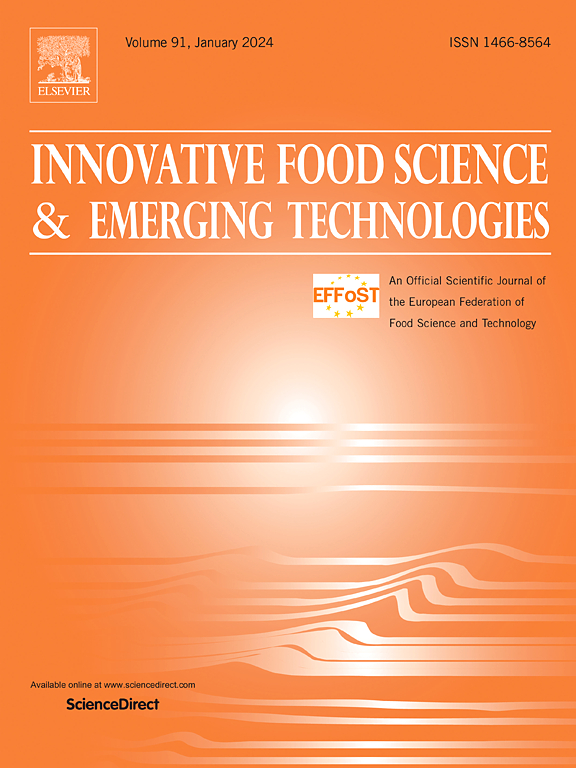Synergistic combination of ultrasound and bacteriophages therapy for effective control of biofilm formation by multidrug-resistant Salmonella Typhimurium
IF 6.3
1区 农林科学
Q1 FOOD SCIENCE & TECHNOLOGY
Innovative Food Science & Emerging Technologies
Pub Date : 2025-07-18
DOI:10.1016/j.ifset.2025.104117
引用次数: 0
Abstract
Salmonella Typhimurium is a foodborne pathogen threatening public health by forming resilient biofilms on food-processing surfaces. Bacteriophage-based intervention has gained significant recognition as an eco-friendly and sustainable approach for combating pathogenic bacteria and addressing antimicrobial resistance dissemination. However, the effectiveness of phage treatment is limited by the physical barrier of biofilms and the formation of phage-resistant strains. This study aimed to develop an ultrasound-assisted phage therapy to control multidrug-resistant Salmonella biofilms in the food industry. Specifically, using multidrug-resistant S. Typhimurium N20 as the host, three novel virulent phages, including two short-tailed phages (ST-YZU-14 and ST-YZU-19) and one Myoviridae phage (ST-YZU-21) were identified. These phages showed high efficiency, with large burst sizes (50, 158, and 138 PFU/host cell, respectively), and short latency periods (10, 5, and 15 min, respectively). Their optimal multiplicity of infection (MOI) values were 0.1, 0.1, and 1, respectively. The complete genomic sequences of the phages ranged from 40,083 to 44,328 bp and GC content of 48.25 %–49.56 %, which consisted of 43, 47, and 275 open reading frames for ST-YZU-14, ST-YZU-19, and ST-YZU-21, respectively. Genomes without drug-resistant genes and virulence determinants were confirmed. Phages exhibited strong inhibitory effects against S. Typhimurium in pork at 4 °C (0.32–0.58 Log CFU/g) and 37 °C (1.14–1.54 Log CFU/g). Finally, ultrasound-phage combination therapy effectively eradicated S. Typhimurium biofilms on polyethylene and stainless steel substrates, with synergistic treatments reducing biofilm formation to undetectable levels in some cases, and achieving up to 79.9 % reduction in thickness and 99.15 % reduction in coverage via confocal laser scanning microscopy (CLSM) analysis. This study established a phage-ultrasound combination therapy as a powerful strategy against biofilms of multidrug-resistant Salmonella strains.
超声与噬菌体联合治疗对多重耐药鼠伤寒沙门菌生物膜形成的有效控制
鼠伤寒沙门氏菌是一种食源性病原体,通过在食品加工表面形成弹性生物膜威胁公众健康。以噬菌体为基础的干预作为对抗致病菌和解决抗菌素耐药性传播的一种生态友好和可持续的方法已得到广泛认可。然而,噬菌体治疗的有效性受到生物膜的物理屏障和噬菌体抗性菌株的形成的限制。本研究旨在开发一种超声辅助噬菌体疗法来控制食品工业中多重耐药沙门氏菌生物膜。具体而言,以耐多药鼠伤寒沙门氏菌N20为宿主,鉴定出3种新型强毒噬菌体,包括2种短尾噬菌体(ST-YZU-14和ST-YZU-19)和1种肌病毒科噬菌体(ST-YZU-21)。这些噬菌体表现出高效率,爆发大小大(分别为50、158和138 PFU/宿主细胞),潜伏期短(分别为10、5和15 min)。其最优感染多重性(MOI)值分别为0.1、0.1和1。噬菌体全基因组序列范围为40,083 ~ 44,328 bp, GC含量为48.25% ~ 49.56%,其中ST-YZU-14、ST-YZU-19和ST-YZU-21分别包含43、47和275个开放阅读框。证实基因组中没有耐药基因和毒力决定因素。在4°C (0.32-0.58 Log CFU/g)和37°C (1.14-1.54 Log CFU/g)条件下,噬菌体对猪肉鼠伤寒沙门氏菌有较强的抑制作用。最后,超声-噬菌体联合治疗有效地根除了聚乙烯和不锈钢基底上的鼠伤寒沙门氏菌生物膜,在某些情况下,协同治疗将生物膜的形成减少到无法检测的水平,通过共聚焦激光扫描显微镜(CLSM)分析,其厚度减少了79.9%,覆盖范围减少了99.15%。本研究建立了噬菌体-超声联合治疗作为对抗多重耐药沙门氏菌菌株生物膜的有效策略。
本文章由计算机程序翻译,如有差异,请以英文原文为准。
求助全文
约1分钟内获得全文
求助全文
来源期刊
CiteScore
12.00
自引率
6.10%
发文量
259
审稿时长
25 days
期刊介绍:
Innovative Food Science and Emerging Technologies (IFSET) aims to provide the highest quality original contributions and few, mainly upon invitation, reviews on and highly innovative developments in food science and emerging food process technologies. The significance of the results either for the science community or for industrial R&D groups must be specified. Papers submitted must be of highest scientific quality and only those advancing current scientific knowledge and understanding or with technical relevance will be considered.

 求助内容:
求助内容: 应助结果提醒方式:
应助结果提醒方式:


